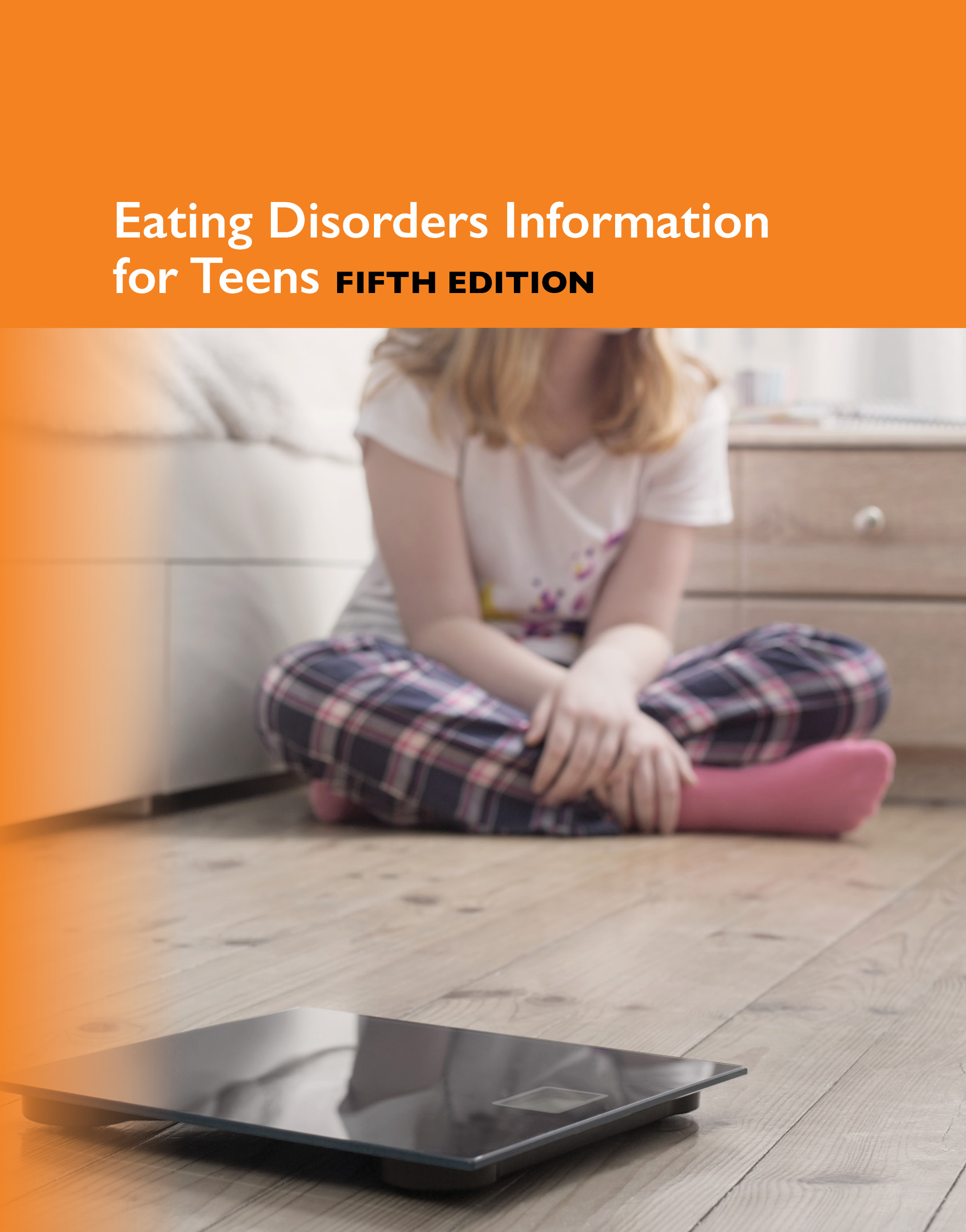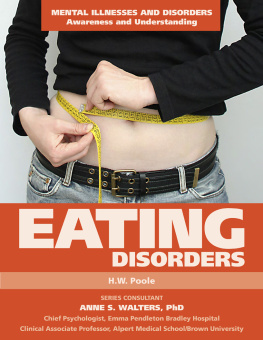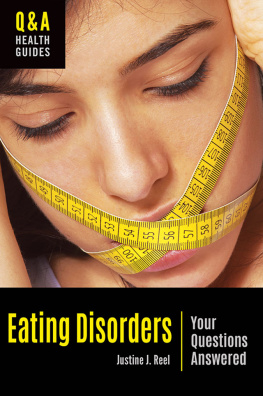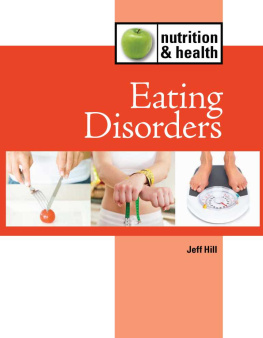Kevin Hayes - Eating Disorders Information for Teens
Here you can read online Kevin Hayes - Eating Disorders Information for Teens full text of the book (entire story) in english for free. Download pdf and epub, get meaning, cover and reviews about this ebook. year: 2021, publisher: Omnigraphics, genre: Children. Description of the work, (preface) as well as reviews are available. Best literature library LitArk.com created for fans of good reading and offers a wide selection of genres:
Romance novel
Science fiction
Adventure
Detective
Science
History
Home and family
Prose
Art
Politics
Computer
Non-fiction
Religion
Business
Children
Humor
Choose a favorite category and find really read worthwhile books. Enjoy immersion in the world of imagination, feel the emotions of the characters or learn something new for yourself, make an fascinating discovery.
- Book:Eating Disorders Information for Teens
- Author:
- Publisher:Omnigraphics
- Genre:
- Year:2021
- Rating:3 / 5
- Favourites:Add to favourites
- Your mark:
- 60
- 1
- 2
- 3
- 4
- 5
Eating Disorders Information for Teens: summary, description and annotation
We offer to read an annotation, description, summary or preface (depends on what the author of the book "Eating Disorders Information for Teens" wrote himself). If you haven't found the necessary information about the book — write in the comments, we will try to find it.
Consumer health information for teens about causes, prevention, and treatment of eating disorders, along with tips for healthy eating. Includes index and resource information.
Eating Disorders Information for Teens — read online for free the complete book (whole text) full work
Below is the text of the book, divided by pages. System saving the place of the last page read, allows you to conveniently read the book "Eating Disorders Information for Teens" online for free, without having to search again every time where you left off. Put a bookmark, and you can go to the page where you finished reading at any time.
Font size:
Interval:
Bookmark:

Teen Health Series
EATING DISORDERS
INFORMATION FOR
TEENS FIFTH EDITION
Teen Health Series
EATING DISORDERS
INFORMATION FOR
TEENS FIFTH EDITION
Health Tips about Anorexia, Bulimia, Binge Eating, and Body Image Disorders
Including Information about Risk Factors, Prevention, Diagnosis, Treatment, Health Consequences, and Other Related Issues

615 Griswold St., Ste. 520,
Detroit, MI 48226
Bibliographic Note
Because this page cannot legibly accommodate all the copyright notices, the Bibliographic Note portion of the Preface constitutes an extension of the copyright notice.
* * *
OMNIGRAPHICS
Kevin Hayes, Managing Editor
* * *
Copyright 2021 Omnigraphics
ISBN 978-0-7808-1923-8
E-ISBN 978-0-7808-1924-5
Library of Congress Cataloging-in-Publication Data
Names: Hayes, Kevin (Editor of health information), editor.
Title: Eating disorders information for teens / edited by Kevin Hayes.
Description: Fifth edition. | Detroit, MI: Omnigraphics, [2021] | Series: Teen health series | Includes index. | Audience: Ages 13 | Audience: Grades 7-9 | Summary: Provides consumer health information for teens about risk factors, prevention, diagnosis, and treatment of eating disorders, along with tips for healthy eating. Includes index and more information about nutrition, weight management, physical fitness, and mental fitness-- Provided by publisher.
Identifiers: LCCN 2021018678 (print) | LCCN 2021018679 (ebook) | ISBN 9780780819238 (library binding) | ISBN 9780780819245 (ebook)
Subjects: LCSH: Eating disorders--Juvenile literature. | Eating disorders in adolescence--Juvenile literature.
Classification: LCC RC552.E18 E2836 2021 (print) | LCC RC552.E18 (ebook) | DDC 616.85/2600835--dc23
LC record available at https://lccn.loc.gov/2021018678
LC ebook record available at https://lccn.loc.gov/2021018679
Electronic or mechanical reproduction, including photography, recording, or any other information storage and retrieval system for the purpose of resale is strictly prohibited without permission in writing from the publisher.
The information in this publication was compiled from the sources cited and from other sources considered reliable. While every possible effort has been made to ensure reliability, the publisher will not assume liability for damages caused by inaccuracies in the data, and makes no warranty, express or implied, on the accuracy of the information contained herein.

This book is printed on acid-free paper meeting the ANSI Z39.48 Standard. The infinity symbol that appears above indicates that the paper in this book meets that standard.
Printed in the United States
TABLE OF CONTENTS
PREFACE
About This Book
There are many misconceptions in our society about what causes eating disorders. Eating disorders are rarely about food or wanting to be thin. Some people think that what they eat and exercise are important components of healthy lifestyles. For others, however, these concerns become extreme. Some of them develop serious disruptions in eating patterns, become fixated on food worries, and experience severe distress about body weight and shape. These obsessions are characteristic of eating disorders. Eating disorders involve extreme emotions, attitudes, and behaviors involving weight and food. The lifetime prevalence of eating disorders was 2.7 percent. Less than 6 percent of people with eating disorders are medically diagnosed as underweight. The most common eating disorders include anorexia nervosa, bulimia nervosa, and binge-eating disorder. Based on research, the median age of onset was 21 years old for binge-eating disorder and 18 years old for both bulimia nervosa and anorexia nervosa. A combination of biological, psychological, and environmental factors contribute to an eating disorder developing in a person. The disorder touches all different socioeconomic and ethnic backgrounds, and all different ages. Females are more likely to get eating disorders than males, but statistics on the prevalence of eating disorders in the United States can vary widely.
Eating Disorders Information for Teens, Fifth Edition discusses the differences between healthy eating patterns and anorexia nervosa (AN), bulimia nervosa (BN), binge-eating disorder (BED), emotional eating, orthorexia, pica, and other eating disorders. It explains how to recognize eating disorders, how they are diagnosed, the types of treatment available, and guidelines for relapse prevention. Facts about medical consequences, co-occurring conditions, and other diseases that may be complicated by an eating disorder are also included. A special section reports on healthy weight management and exercise plans. The book concludes with directories of resources for additional information about eating disorders, nutrition, and fitness.
How to Use This Book
This book is divided into parts and chapters. Parts focus on broad areas of interest; chapters are devoted to single topics within a part.
provides basic facts about eating disorders. It discusses how to identify healthy eating patterns, and the types of influences that can lead to disruptions in normal eating patterns. Other factors that could contribute to eating disorders such as genetics, and negative body image are also discussed. Also, it discusses eating disorders in male and female athletes. The part concludes with a chapter on weight loss and myths related to nutrition.
provides facts about the three most common types of eating disorders: anorexia nervosa, bulimia nervosa, and binge-eating disorder. It also offers information about sleep eating syndrome, pica, and other lesser-known types of eating disorders. It discusses other related concerns, including rumination disorder, compulsive exercise and body dysmorphic disorder (BDD), and acid reflux in teens.
summarizes some of the most commonly experienced physical and mental problems associated with eating disorders, including the effects of inadequate nutrition, risks associated with obesity, oral health implications, osteoporosis, and fertility and pregnancy issues. It also discusses other conditions that can impact the progression and outcomes of eating disorders. The part concludes with the impact eating disorders can have on mental health, and the potential implications associated with that.
talks about the common symptoms of eating disorders and how to identify someone who may be struggling with an eating disorder. Information about diagnosis and types of treatment along with medications, improving self-esteem and ways to deal with body image issues are also included.
provides information on how to build a healthy eating style and improve your eating habits. It offers parenting tips and food safety tips for teens on how to achieve a healthy weight through good dietary habits and calorie management. Additionally, it provides information on how to avoid potential relapse. The part concludes with the importance of good physical and mental health.
provides directories of resources that offer more information about eating disorders, nutrition, weight management, and physical and mental fitness.
Bibliographic Note
This volume contains documents and excerpts from publications issued by the following U.S. government agencies: Centers for Disease Control and Prevention (CDC); Dietary Guidelines for Americans ( DGA ); Genetic and Rare Diseases Information Center (GARD); girlshealth.gov; MedlinePlus; MentalHealth.gov; MyPlate; National Center for Complementary and Integrative Health (NCCIH); National Heart, Lung, and Blood Institute (NHLBI); National Institute of Arthritis and Musculoskeletal and Skin Diseases (NIAMS); National Institute of Diabetes and Digestive and Kidney Diseases (NIDDK); National Institute of Mental Health (NIMH); National Institutes of Health (NIH); NIH News in Health ; NIH Osteoporosis and Related Bone Diseases National Resource Center (NIH ORBD NRC); Office of Disease Prevention and Health Promotion (ODPHP); Office on Womens Health (OWH); PubMed; StopBullying.gov; Substance Abuse and Mental Health Services Administration (SAMHSA); U.S. Department of Agriculture (USDA); U.S. Department of Homeland Security (DHS); and U.S. Department of Veterans Affairs (VA).
Font size:
Interval:
Bookmark:
Similar books «Eating Disorders Information for Teens»
Look at similar books to Eating Disorders Information for Teens. We have selected literature similar in name and meaning in the hope of providing readers with more options to find new, interesting, not yet read works.
Discussion, reviews of the book Eating Disorders Information for Teens and just readers' own opinions. Leave your comments, write what you think about the work, its meaning or the main characters. Specify what exactly you liked and what you didn't like, and why you think so.












